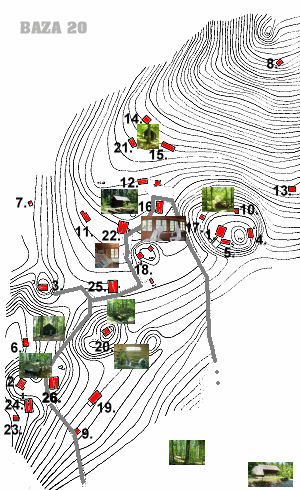| 1 | 2 | 3 |
| [ SLOVENSKO]
Kočevski rog covers an area of over 5oo
square kilometres of dynamic Karstic terrain between Kočevsko-Ribniško
Polje, Suha Krajina, Novo Mesto valley and Bela Krajina. The highest peak
is Veliki Rog, rising 1099 metres above sea level. Until recently the relatively
cold and damp climate prevented most human interventions in the local natural
environment. As a result, in the vast fir and beech forests, all
predators have survived, including birds of prey, owls and other wildlife.
Three original forests have been preserved in Rog. Because of the impassability
of the terrain, thick forests and unfriendly climate, the first proper
settlements were not established until the 14th century with the arrival
of German colonists known as the Götscher. They were predominantly farmers,
craftsmen, carpenters and peddlers. When, in 1941, Yugoslavia was invaded,
the area was annexed to Italy, which in the winter of 1941/42 caused the
Götscher to move to the lower Posavje region, from where over 36,000 s
had previously been expatriated. With the departure of the Gotscher, over
forty villages and hamlets were abandoned. Today, they are overgrown with
forest.
Almost at the same time, BAZA 21 at the foot of
Kragulji Vrh became he headquarters of the military leadership -the Main
Headquarters of the National Liberation Army and Partisan Detachments of
Slovenia. Near Cink, BAZA 15 and BAZA 15a were built, accommodating schools
of higher education of the Communist Party and SKOJ (Communist Youth Ass.
of Yugoslavia).
|
|
 |
| BAZA 20. For the new Location of the political
leadership, a deep Karstic hollow was selected just below the altitude
of 708 metres not far from Červan road. The decision was influenced by
the configuration of the terrain, thick vegetation, accessibility, possibility
of bringing in supplies and, above all, security.
During the Rog Offensive, the Jurče partisan troop set up camp in the hollow for several days, without being discovered by Italians. The first building in BAZA 20 was constructed when the leadership was still stationed in Polhograjski Dolomiti. The leadership moved to BAZA 20 on 17 April 1943. The number of inhabitants grew steadily and new buildings were added. The first buildings were constructed with timber from the Italian Emona company, whereas for later buildings, material was secured in villages at the foot of Rog. Wooden boards were hewn at the Spreitzer sawmill in Stare Žage and at a sawmill in Soteska. Doors and already glazed windows were taken from the abandoned Götscher houses, but tools and other necessary material were procured in shops in the valley. BAZA 20 provided home and working environment members of the Executive Committee of the Liberation Front, Supreme Council of the Liberation Front, Central Committee of the Communist Party of Slovenia, Anti-Fascist Council of the National Liberation of Yugoslavia (AVNOJ) and Agitation and Propaganda Commission, for editors of periodicals and others. By the Italian capitulation on 9 September 1943, thirteen buildings had been erected. In addition to those accommodating the members of the leadership, a radio and telegraph building, a radio station, a kitchen and two dormitories for the kitchen staff and the guards were constructed. In 1944 a kitchen warehouse was built along with a separate kitchen and warehouse for the guard battalion, an electric power plant, two dormitories for the guards and propaganda activists and additional buildings for the Liberation Front and Communist Party of Slovenia. The number of inhabitants of BAZA 20 kept expanding. In the summer of 1944 it accommodated some 140 individuals, while by autumn the population had risen to as many as 180 people. Thanks to exceptional security and camouflage measures, BAZA 20 was never discovered. BAZA 20 is the only such headquarters of
a European resistance movement which is still preserved. It has become
an important monument of the state. Together with the preserved
hospitals of Jelendol and Zgornji Hrastnik it was declared a cultural monument
in 1952. All 26 buildings still stand. They are maintained by the Novo
Mesto department of the Institute for the Protection of Cultural Heritage
of the Republic of Slovenia, and the museum display has been provided since
1994 by the Dolenjska Museum of Novo Mesto and its Kočevski Rog branch
at Lukov Dom near BAZA 20.
|
|
|
| BAZA
20 ,
All rights of this
site are reserved. Avtor: Boštjan Burger, September 2005, tekst: Jože Saje
(Dolenjski muzej)
|